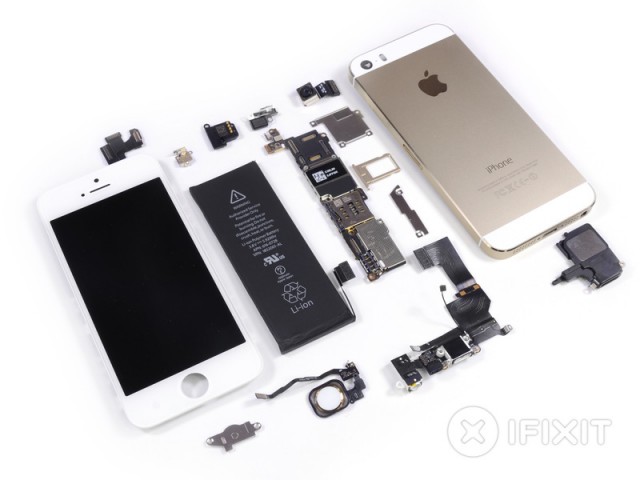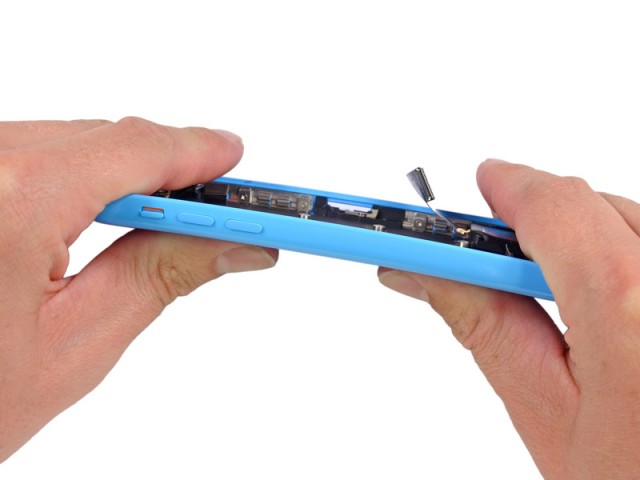
Some advance reviews of Apple's iPhone 5S have already showed up, but as of yet few have dared to physically pull apart the new iPhone to see what makes it tick. The folks over at iFixit have gotten their hands on one of those rare gold iPhones you're all trying to buy, sacrificing it in the name of Knowledge.
What iFixit discovered was a mix of old and new, much in keeping with the new-stuff-inside, similar-stuff-outside approach that Apple usually takes with its "S" phones. The 4-inch 1136×640 display is identical to last year's (excepting the normal variance you can get from phone-to-phone depending on where Apple sourced the panel) and like the iPhone 5, it integrates the glass layer, the capacitive touch layer, and the LCD itself into a single piece to reduce thickness. The dual-band 802.11n Wi-Fi module and its Broadcom BCM4334 chipset are also near-identical to last year's model.

Other, small upgrades abound once you remove the device's screen. Its battery capacity has been increased to 1560 mAh, up from 1440 mAh in the iPhone 5 and roughly in line with FCC documents that made the rounds last week. This larger battery should provide a marginal bump in runtime over the iPhone 5, though some of its increased capacity may be eaten up by the slightly larger A7 chip. The Qualcomm MDM9615M LTE modem is exactly the same as last year, but an upgraded Qualcomm WTR1605L LTE transceiver chip will support more LTE bands than the RTR8600 chip in the iPhone 5. It's worth noting that the MDM9615M doesn't support LTE Advanced speeds, a standard which isn't in wide use now but may be by the time 5S buyers' contracts are up in two years. An upgraded iSight camera module from Sony is also included, and it's accompanied by the new dual-LED flash.
Finally, the 5S' biggest performance upgrade: the A7 SoC. This chip is the first to market to use the ARMv8 instruction set, which is both inherently 64-bit (an easy bullet point to market) and better-optimized than the outgoing ARMv7 ISA (which actually increases performance). The A7 appears to have 1GB of RAM stacked on top in a package-on-package configuration, which is the same amount of memory that the iPhone 5 (and the fourth-generation iPad) has. Markings on the A7 lead iFixit to believe that we're looking at faster, more efficient DDR3 rather than the DDR2 we saw last year.

One of the biggest questions we still have about the A7 is its manufacturer, which could also help us determine its exact manufacturing process—it's likely that it's being built on something other than the 32nm Samsung process that Apple has been using in its chips lately, and persistent years-old rumors about a deal with TSMC have us wondering (though the latest scuttlebutt says that transition, if it occurs, will be happening next year). The well-connected people at AnandTech believe that the A7 uses Samsung's 28nm process, which would let Apple make the A7 a slightly more powerful, more complex chip than the A6 without making it much physically larger than its predecessor.
Curiously, iFixit didn't notice anything that looked like that M7 co-processor that Apple talked up at its September 10 event. The teardown bosses speculate that it might not be a separate chip after all, but rather a block integrated into the main A7 chip itself—iFixit doesn't seem sure of this, however, and neither are we. As with so much else about the A7, we're left waiting for an outlet like Chipworks to get us a good die shot before we can talk with confidence about the composition (or the manufacturing process) of either chip.
As for the somewhat-arbitrary "repairability rating" that iFixit assigns to all of the products it tears down, the 5S receives a six out of ten where the iPhone 5 received a seven out of ten. Issues cited were the fused-together screen, which must be replaced entirely if any one layer is broken or defective; the stronger adhesive holding the battery in the case; the easy-to-break cable for the fingerprint sensor; and the Pentalobe screws used to hold the whole thing together. iFixit praised the 5S for having a screen that came off first, simplifying repairs of this oft-broken part, and for having an easy-to-access (if not easy-to-remove) battery.

iFixit has also torn down the cheaper iPhone 5C, and as expected it is largely identical to the iPhone 5, with one or two small exceptions. For one, the iPhone 5C tosses the iPhone 5's RTR8600 chip for the same WTR1605L as the iPhone 5S—it was made clear at Apple's September 10 event that both the 5C and 5S supported the same LTE bands, but it's nice to see the proof. The battery is also slightly larger than the iPhone 5's at 1510 mAh. Finally, the rear shell of the 5C is heavier than the aluminum shells of the 5 and 5S, but iFixit says the plastic part is "as strong and blue as Captain Planet," which should be good enough to allay concerns about its durability as long as you understand references to campy early-90s cartoons.
reader comments
35